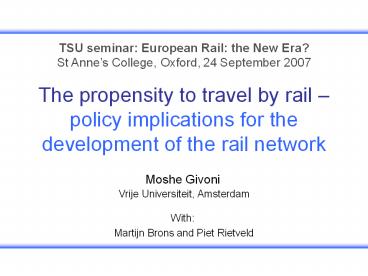The propensity to travel by rail - PowerPoint PPT Presentation
1 / 15
Title:
The propensity to travel by rail
Description:
Access facilities: Park&Ride, Guarded bike-parking. Post-code characteristics ... Guarded bike-parking (in at least one station) -1160. Public Transport Frequency ... – PowerPoint PPT presentation
Number of Views:44
Avg rating:3.0/5.0
Title: The propensity to travel by rail
1
The propensity to travel by rail policy
implications for the development of the rail
network
TSU seminar European Rail the New Era? St
Annes College, Oxford, 24 September 2007
Moshe Givoni Vrije Universiteit, Amsterdam
- With
- Martijn Brons and Piet Rietveld
2
Research objective
- Understanding how rail use is influenced by
- The level of rail service provided
- The accessibility of the rail station
- Post-code characteristics
OR Should a rail network serve the four corners
of a country?
3
Background (1)
- Dutch rail network
- 363 stations
- 2811 km
- 68 m/km2
- 92 of population live less than 10km from a
train station
4
Background (2)
Trips per person per year and rail share in the
489 Dutch municipalities (2002/2003)
Rail share in (land) passenger-km 8.2 (UK
5.3, EU25 6.5).
5
Model and Data (1)
Number of rail trips per person per year
f(rail service, access to station, PC
characteristics)
6
Model and Data (2)
Descriptive statistics
7
Model and Data (3)
- The accessibility of the rail station
- Average distance (km), PC-centroid to rail
station 8.68km - Public transport travel time (minutes),
PC-centroid to rail station 25.4min - Public transport service frequency (services per
hour) 1.98 - Access facilities ParkRide, Guarded bike-parking
- Post-code characteristics
- Population density (population / hectare)
- population over 65
- Average income per inhabitant (Euro/year)
11,067 - Number of cars per household 0.97
8
Results (1)
9
Results (2)
10
Results (3)
11
Results (4)
12
Conclusions (1)
- Policy makers and rail operators have control on
the level of rail service provided and the access
to it (not on the characteristics of the
population served) - The two are substitutes (when a rail service is
provided) - Improving access to stations probably less costly
than improving the rail service (harder to
achieve from an organizational perspective) - Reducing distance to station opening new
stations gt costly, travel time penalties to
travelers - Reducing travel time to station, more important
gt better public transport services to stations
Rail operators should focus attention also
outside the train part of a rail journey
13
Conclusions (2)
Investments in rail infrastructure must be very
selective
- Investments should be directed to where the level
of service is already relatively high (where
demand is high) - Where current rail service is relatively low (the
network periphery) investments should be
directed to improve access to the station - Regional accessibility accessibility to the
rail network (does not have to be by rail)
A rail network need not serve the four corners of
a country (continent) under all circumstances.
Focus should be on the transport network at large
14
Discussion
- The Reshaping of British Railway (1963)
- The Beeching Report
- Investment in the main inter-city routes
- Substitution of rural rail services by bus
services (to the main railway stations?)
- Integrated Transport Policy
- Transport White Paper (1998)
- In (UK, EU) transport policy INTEGRATION gave
its place to SUSTAINABILITY - Integration between modes gt prerequisite to
reduce car use and increase rail use
15
Thank you! mgivoni_at_feweb.vu.nl (From 1 November
TSU, Oxford)
This research is carried out as part of a Marie
Curie Fellowship and the TRANSUMO project
reliability of transport chains We thank the
Dutch Railways (NS) for the data































